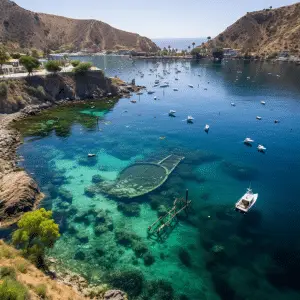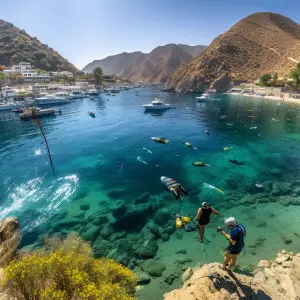Catalina– or Santa Catalina Island– is a lovely resort island destination off the coast of Los Angeles. Its laid-back resort vibe paired with the most majestic views of the Pacific Ocean makes it a perfect weekend getaway for Californians, like a piece of the Mediterranean right in their backyard.
There are two main areas to go to when you visit the island– Two Harbors, and Avalon. The first one is a resort town with a restaurant and a store. The latter is a charming 650-acre town with lots of homes, shops, restaurants, hotels, and various activities to do.
And if you’re a bigger fan of the ocean than of land, and scuba diving is your thing, then you’re in for a treat. Catalina Island is known for having the healthiest marine environment in the world. The island is a reliable place to see California’s ethereal kelp forests. The chance to encounter the endangered giant black sea bass also draws divers to the island year after year.
History

The history of this rocky island starts as far back as 7,000 years ago, when the Tongva tribe used to settle on the island. The island was Pimuu’nga or Pimu by the locals before Spanish explorers arrived and claimed the island as their own.
The island was sporadically used by pirates, smugglers, and hunters before it was bought by the chewing gum tycoon William Wrigley Jr in the early 1920s. He then established the Catalina Island Conservancy to ensure that the island would remain pristine and avoid becoming overrun by resorts.
According to a 2010 census, the population of the island was about 4,000, and 90% of its residents live on Avalon, the only incorporated city on the island. Its population may be small, but the island has been known as a tourist hub for well over a century, with over a million people traveling to the island every year.
This historic seaside destination offers a wide variety of activities for its visitors– glass bottom boat tours, scuba diving, and snorkeling are some of the most popular activities to do on its oceans.
Wildlife
Catalina Island originally lacked any terrestrial life. Being disconnected from the mainland, any plants or animals that arrived on the island had to make their way across the open ocean. Today, it is home to at least fifty endemic species and subspecies that are unique only to Catalina. This limited distribution of a species may result from the extinction of the original population on the mainland combined with its continued survival on the island where there may be fewer threats to its continued existence.
The island is mostly managed by the Catalina Island Conservancy, which protects the natural and cultural heritage of the island. It serves as a steward for over 42,000 acres of land. One of the species the conservancy aims to protect is the endangered island fox. There are currently more or less 1,570 known foxes living on the island today.
Catalina also serves as the epicenter of some of the most diverse marine life in the world. It is home to thousands of fish species, nudibranchs, crustaceans and invertebrates, mammals, and bright corals. It is also possible to encounter sharks when diving on Catalina Island.
If you’re lucky, you’ll be able to see the majority of the marine life in this list when diving in Catalina: Harbor Seals, California Sea Lions, Dolphins, Humpback Whales, Wolf Eel, Giant Black Sea Bass, Large Schools of Fish, Pacific Seahorse, Torpedo Rays, Angel Shark, Blue Shark, Makos Shark, Horn Shark, Leopard Shark, Nudibranchs, Molluscs, Crustaceans, Sponges and Anemones.
Getting There
Getting to Catalina Island by high-speed ferry usually only takes an hour. Visitors can pick between the Catalina Express or the Catalina Flyer. Its pickup points around Southern California include Long Beach, San Pedro, Dana Point, and Newport Beach. These ferries depart several times a day and roundtrip tickets cost around $75.
Helicopter services are also offered in Long Beach and San Pedro. Catalina Island’s only airport is privately owned but private planes can fly and land from there.
Many visitors who choose to sail to the island by ferry can sometimes get a free whale-watching experience. Some ferry captains stop the boat and announce to passengers sightings of breaching whales crossing the island.
Diving
With visibility exceeding 90 feet, divers will be able to see up close and personal the magical kelp forests and plenty of colorful sea life found in Catalina’s waters. If you’re one of the lucky ones, you’ll probably be able to play with the friendly sea lions on the island. It will truly be an experience you will never forget.
Its most distinctive feature, though, is the 65-foot giant kelp forests that shoot up from the ocean floor up to the surface. These underwater forests play host to a wide array of aquatic life on the island. A lot of octopuses and eels can often be seen hiding in the cracks and crevices of underwater rocks. From sharks to shrimps, fishes to anemones– it’s undeniable that this is the healthiest marine environment in the world.
Catalina Island welcomes divers with all sorts of experiences. It doesn’t matter if you’re a novice diver or a professional one; Catalina offers many different dive sites on the island to suit divers of all levels. There are also a lot of great places to snorkel on the island. Catalina Island is also listed as one of the 5 Best Places for Scuba diving in California by our writers.
Conditions
The water temperatures when going diving in Catalina can depend on which side of the island you’re diving on, and the season. It varies greatly from the mid-50s in the winter to 70 degrees in the summer. Make sure to be prepared for the occasional strong currents, though.
Visibility
Visibility is generally good, averaging between 30 and 40 feet. It’s particularly higher during the winter and lowers in the summer. This is mainly because of the heavy phytoplankton bloom in the nutrient-rich water caused by the warmth. January and February offer the best visibility but colder waters.
Popular Sites
The world under Catalina can take a lifetime to explore, and the island is home to some of the most popular dive sites in California. Its rich biodiversity and abundant marine life easily make it the best place to go scuba diving in Southern California.
Catalina offers a variety of underwater experiences depending on what you’re interested in. We have listed our recommended locations to visit.
Casino Point Dive Park
Divers can enter the sea through the stairs in Casino Point Park, which directly takes them straight into an underwater adventure. Miles of lush dancing kelp greet divers upon their descent alongside friendly garibaldi. Lucky divers who decide to venture into deeper parts of the ocean may also get to see the elusive giant sea bass that grows up to 550 pounds.
Direct shore access and sea life only feet below the surface make this site a great beginner dive, though divers should take care not to get entangled in the kelp.
Blue Cavern Point
Blue Cavern Point is a great wall dive with even greater visibility. Divers can explore the many caves and caverns carved out of a deep shelf located in this area. The occasional strong currents also give the opportunity for drift diving.
Its majestic blue waters are home to various sharks, sea lions, and harbor seals.
Farnsworth Banks
The pinnacles found at Farnsworth Banks are easy to miss. Its strong currents sometimes push divers past it and also make it difficult to anchor. It is only recommended for advanced open-water divers and above.
But if you’re persistent enough, then you’ll be rewarded with views of hundreds upon hundreds of purple hydro coral, nudibranchs, pelagic fish, and torpedo rays.
Ship Rock
Like many diving spots found on Catalina Island, you’ll find vast forests full of lush kelp– serving as home to various schools of fish and angel sharks– here in Ship Rock. You’ll also find plenty of nudibranchs if you venture deeper into the ocean.
Two Harbors
The Two Harbors area is also dominated by giant kelp forests, which is a great backdrop for some wide-angle underwater photography. Several diving sites to explore in Two Harbors include Bird Rock, Sea Fan Grotto, and the Eagle Reef.
West End Cove
The diving spot in West End Cove offers one of the clearest and most visible on Catalina Island. The trade-off, however, is its occasional strong currents. Various schools of fish like jack and mackerel are common here. Some yellowtails can also be found.
Italian Gardens

The Italian Gardens is a fairly large cobblestone beach and is often the most common spot frequented by black sea bass. During the summer and fall seasons, many can be found at the base of the kelp forests on the beach.
Rock Quarry, Long Point, and Eagle Rock
These areas are home to stunning sea fans, angel sharks, and scythe butterflyfish. These dive sites are also some of the best spots for wide-angle underwater photography on Catalina Island.
Long Point in particular is a wall dive with lots of schooling fish, and lush kelp forests. These spots usually offer great visibility.
